August 4, 2008 UPDATE!
USA-C2C.com just got bigger, better, easier to search and more interactive.
We are very happy to announce that we are now back online, updating often at www.NationalParksOnline.net.
Now you can find all the National Park reviews and travel tips you need with an easy search. We will also keep the site lively with National Park news, our views and stories and photos from our two year trip that you haven't seen yet!
Did we get something wrong? Do you disagree with one of our reviews? Was your experience different? www.NationalParksOnline.net gives you the opportunity to add your two cents through comments, polls (and maybe even a few contests).
What are you waiting for? Change your bookmarks to point to www.NationalParksOnline.net and come visit us at our new site!
IMPORTANT ANNOUNCEMENT
As you might have noticed we are on a little break here at ww.usa-c2c.com. Take solace, the site is not dead. We are working on many redesign issues and a site relocation. Will we re-emerge soon bigger, better, and more interactive.
Thank you for your patience,
the usa-c2c team
April 28, 2008
Today's Featured Review:
Congaree National Park
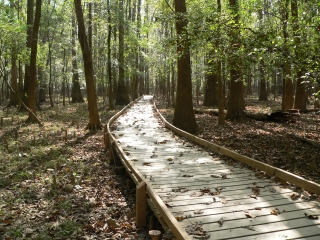 Environmental advocates can sometimes be heard to say "Make Earth Day everyday". Well, we are going to heed their call and continue highlighting National Park areas that examine the glories of conservation, preservation, and sustainability. Today we move across the country from California's Muir Woods to another park that boasts oversized trees: South Carolina's Congaree National Park. Environmental advocates can sometimes be heard to say "Make Earth Day everyday". Well, we are going to heed their call and continue highlighting National Park areas that examine the glories of conservation, preservation, and sustainability. Today we move across the country from California's Muir Woods to another park that boasts oversized trees: South Carolina's Congaree National Park.
Congaree NP is home to North America’s largest, at 22,000 acres, intact floodplain forest. What that means is a great diversity of tall trees, a swamp-like feel, lots of birds and even more mosquitoes.
In the late 19th century, there were 52 million acres of old-growth floodplain forests in the southeastern United States. In just 50 years, logging companies harvested nearly all of these forests. Today, Congaree NP’s 11,000 acres of old-growth floodplain forest make it the largest example of this ecosystem in North America. The second largest old-growth floodplain forest totals just 2,000 acres.
Congaree NP’s excessively wet climate initially protected it from logging interests but in the 1950’s, conservationist Harry Hampton launched a passionate campaign to save this precious example of the earth’s natural past. A bitter fight between conservationist and loggers ensued, ending when the Congress set aside the land as Congaree Swamp National Monument in 1976. Congaree NP became an International Biosphere Reserve in 1983.
Click Here to Read More about Congaree National Park.
April 24, 2008
Today's Featured Review:
Muir Woods National Monument
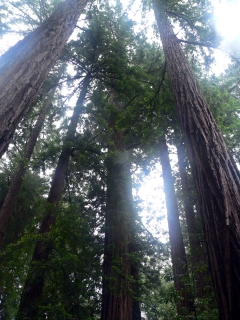 Happy Earth Day week! In honor of wonderful planet Earth we are going to highlight National Park areas this week that examine the glories of conservation, preservation, and sustainability. There's one man that immediately springs to mind when those topics are mentioned: environmentalist pioneer John Muir. It also just so happens that Monday was even his Muir's birthday. He would have been 170 years old, a fraction of the lifespan of one of his beloved Giant Sequoia trees Happy Earth Day week! In honor of wonderful planet Earth we are going to highlight National Park areas this week that examine the glories of conservation, preservation, and sustainability. There's one man that immediately springs to mind when those topics are mentioned: environmentalist pioneer John Muir. It also just so happens that Monday was even his Muir's birthday. He would have been 170 years old, a fraction of the lifespan of one of his beloved Giant Sequoia trees
Muir's home and ranch isn't the only National Park named in the conservationist's honor. Across the bay in Marin County stands a grove of redwoods that were saved by a local businessman in 1905 from the rabid saws of loggers and named after John Muir. They are one of the area's last remaining ancient groves.
It's hard to imagine anyone would ever want to cut down these magnificent trees or how anyone would dare remove their magical powers and stately magnificence from the world. But profit has always triumphed over beauty; the monetary always means more than the spiritual. It takes a special person to stand up in favor of conservation and battle the unbeatable big businesses. John Muir was one of the first but, as the Muir Woods story shows, successive generations have seen his admirable struggle and continued his dream of preserving beauty and preserving life.
Click Here to Read More about Muir Woods National Monument.
April 21, 2008
Today's Featured Review:
John Muir National Historic Site
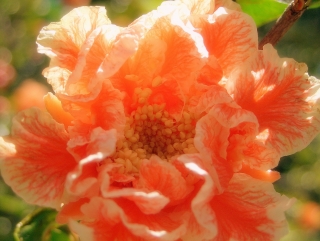 Muir's longtime northern California home and fruit ranch is preserved as part of the National Park Service as John Muir National Historic Site. Muir would probably not recognize his former dwelling. His 2,700 acres have dwindled to 8½. His home’s rural California surroundings have morphed into an industrial and population center. The quiet serenity he enjoyed writing in his second floor “scribble den” would now be impossible because an 8-lane freeway now passes within yards of the room’s windows. Muir's longtime northern California home and fruit ranch is preserved as part of the National Park Service as John Muir National Historic Site. Muir would probably not recognize his former dwelling. His 2,700 acres have dwindled to 8½. His home’s rural California surroundings have morphed into an industrial and population center. The quiet serenity he enjoyed writing in his second floor “scribble den” would now be impossible because an 8-lane freeway now passes within yards of the room’s windows.
When touring the house the freeway is constantly in your line of vision and buzzing in your ears. The home of someone who so loved and promoted the serenity afforded by nature is now in the shadow of concrete and steel. This is both a cruel irony and an effective reminder that the struggle to protect our natural resources and places of beauty is not over. John Muir’s advocacy and the creation of the National Parks was the beginning, not the end.
Click Here to Read More about John Muir National Historic Site.
April 17, 2008
Today's Featured Review:
Tax Day Quiz Answers
We have answers. Just Click Here or Scroll Down past the quiz. We don't want to spoil your test taking fun.
April 15, 2008
Today's Featured Review:
Tax Day Quiz
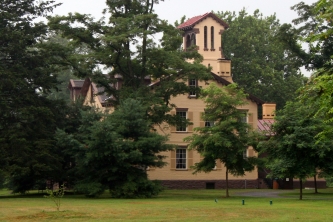 Sick of answering tax-related questions? Too bad. Our Final Four, Yellowstone vs. Yosemite Quiz was so popular that we've come up with a ten-question multiple choice test regarding National Parks and/or Presidential Libraries and their relationship with the subject that Americans love to hate: income tax. Good luck! Answers and explanations either tomorrow or Thursday. The first person to email us at gabandmichael@usa-c2c.com with all ten correct answers gets a long-sleeved, limited edition USA-C2C t-shirt! So check back! Sick of answering tax-related questions? Too bad. Our Final Four, Yellowstone vs. Yosemite Quiz was so popular that we've come up with a ten-question multiple choice test regarding National Parks and/or Presidential Libraries and their relationship with the subject that Americans love to hate: income tax. Good luck! Answers and explanations either tomorrow or Thursday. The first person to email us at gabandmichael@usa-c2c.com with all ten correct answers gets a long-sleeved, limited edition USA-C2C t-shirt! So check back!
Question 1:
Which National Park area is also the site of the world's first central bank not owned by a monarch?
a) Federal Hall National Memorial, New York, N.Y.
b) Independence Hall National Historical Park, Philadelphia, Pa.
c) Pennsylvania Avenue National Historic Site, Washington, D.C.
d) Castillo de San Marcos National Monument, St. Augustine, Fla.
Question 2:
Which National Park site honors the first U.S. Treasury Secretary?
a) George Washington Birthplace National Monument, Pope's Creek, Va.
b) Friendship Hill National Historic Site, New Geneva, Pa.
c) Hamilton Grange National Memorial, New York, N.Y.
d) Martin Van Buren National Historic Site, Kinderhook, N.Y.
Question 3:
Which National Park site honors the longest tenured U.S. Treasury Secretary?
a) George Washington Birthplace National Monument, Pope's Creek, Va.
b) Friendship Hill National Historic Site, New Geneva, Pa.
c) Hamilton Grange National Memorial, New York, N.Y.
d) Martin Van Buren National Historic Site, Kinderhook, N.Y.
Question 4:
Which National Park site celebrates the violent tea-related rejection of the 1765 Stamp Tax?
a) Independence Hall National Historical Park, Philadelphia, Pa.
b) Statue of Liberty National Memorial, New York, N.Y.
c) Colonial National Historical Park, Yorktown, Va.
d) Boston National Historical Park, Boston, Mass.
Question 5:
Which National Park site examines the reason the 1765 Stamp Tax was necessary?
a) Fort Necessity National Historic Site, Farmington, Pa.
b) Springfield Armory National Historic Site, Springfield, Mass.
c) Saugus Iron Works National Historic Site, Saugus, Mass.
d) Salem Maritime National Historic Site, Salem, Mass.
Question 6:
Which National Mall monument honors the president who enacted the first U.S. Income Tax?
a) (George) Washington Monument, Washington, D.C.
b) (Thomas) Jefferson Memorial, Washington, D.C.
c) (Abraham) Lincoln Memorial, Washington, D.C.
d) Franklin Delano Roosevel Memorial, Washington, D.C.
Question 7:
Which site honors the president who pegged the United States to the gold standand, causing a severe four-year economic depression?
a) Martin Van Buren National Historic Site, Kinderhook, N.Y.
b) Andrew Johnson National Historic Site, Johnson City, Tenn.
c) Ulysses S. Grant National Historic Site, St. Louis, Mo.
d) Herbert Hoover National Historic Site, West Branch, Iowa
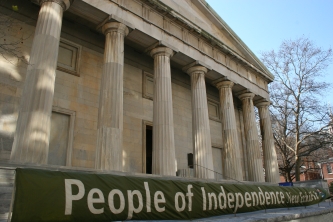
Question 8:
Which site is located in a state whose license plates (and failed state quarter) read "No Taxation Without Representation"?
a) Grant-Kohr's Ranch National Historic Site, Deer Lodge, Montana
b) Fort Laramie National Historic Site, Fort Laramie, Wyoming
c) Ford's Theatre National Historic Site, Washington, D.C.
d) Saint-Gaudens National Historic Site, Cornish, New Hampshire
Question 9:
Which site honors a president who hated banks so much that he took away the federal charter of the Second Bank of the United States?
a) Chalmette Battfield (Andrew Jackon), New Orleans, Louisiana
b) Martin Van Buren National Historic Site, Kinderhook, N.Y.
c) Palo Alto Battlefield National Historic Site (James K. Polk), Brownsville, Texas
d) James A. Garfield National Historic Site, Mentor, Ohio
Question 10:
Which president, during his tenure, dropped the highest bracket tax payment from 70% of personal income to 33.5% while, in the same time period, raising the lowest bracket tax payment from 14% to 15%?
a) (Dwight D.) Eisenhower Center, Abilene, Kans.
b) Ronald Reagan Presidential Library, Simi Valley, Calif.
c) George H. W. Bush Presidential Library, College Station, Texas
d) William J. Clinton Presidential Library, Little Rock, Ark.
Tax Day Quiz Answers
Question 1:
B) Independence Hall National Historical Park. Not only does the park contain the site of the (first) Bank of the United States in what is now known as Carpenter's Hall, but this amazing Philadelphia park also includes the First Bank of the United States and the Second Bank of the United States. There is no place in the United States with more significant monuments to the financial world.
Question 2:
C) Hamilton Grange National Memorial. Alexander Hamilton was the first U.S. Treasury Secretary, a position he held from 1789-1795. He lived at the Hamilton Grange from 1802 until his death in 1804. The Grange is currently being moved in its entirety from its original site in upper Manhattan's W 143rd Street to the corners of 141st Street and St. Nicholas Park, about two city blocks.
Question 3:
B) Friendship Hill National Historic Site. Friendship Hill honors Albert Gallatin who, like Hamilton before him, was not born in the United States. This Swiss emigre was Treasury secretary from 1801-1814. This frugal anti-federalist opposed much of the financial stylings of Alexander Hamilton preferring national debt reduction to bank creation and greater federal controls. Much of Gallatin's savings were wasted by spendthrift fort building. Gallatin's most famous financial accomplishment was the Louisiana Purchase.
Question 4:
D) Boston National Historical Park. Sure, the Boston Tea Party Ship isn't technically a part of the Freedom Trail but the churches and meeting halls were everyone debated the Stamp Act is.
Question 5:
A) Fort Necessity National Historic Site. Fort Necessity was the flash point for the Seven Years War, a global war that put Great Britain severely in debt and gave King George III no other recourse than to raise taxes.
Question 6:
C) Lincoln Memorial. This one was a trick question. With the Revenue Act of 1861 Abraham Lincoln taxed Americans on their income in order to raise money to fight the Civil War. Taxation was essentially prohibited in 1895 by the Supremem Court. The personal Income Tax as we know it was begun in 1913 by Woodrow Wilson. As a result he doesn't have a National Park Site in his honor. Just kidding. Sort of.
Question 7:
C) Ulysses S. Grant National Historic Site. Great general. Bad president.
Question 8:
C) Ford's Theatre National Historic Site. Washington, D.C. of course. Of the other choices Montana and Wyoming residents might like paying taxes the least while New Hampshire's plate says 'Live Free or Die'.
Question 9:
A) Chalmette Battlefield. No one hated banks as much as Andrew Jackson but try as he might he couldn't get rid of them. His insane monetary policies eventually sunk the U.S. into a depression. Luckily for Old Hickory he was out of office at the time and poor Martin Van Buren took all the blame.
Question 10:
B) Ronald Reagan Presidential Library. If AJ is #1 enemy of the bank, the Gipper was definitely the #1 enemy of taxes...well, at least taxes for rich people.
April 7, 2008
Today's Featured Reviews:
Yosemite National Park and Yellowstone National Park
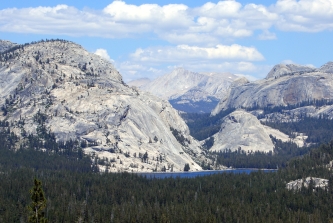 After the weekend's games our Memphis Tigers pick is looking awfully good. Our promise to highlight the super three National Parks...well we sort of slacked on that last week. So today we're bringing you links to two of our Yosemite and Yellowstone reviews. We always mix those parks' names up anyway. Why not mix them up even further? That's not right, you say. OK, smarty pantses. We're having a quiz. We'll say a basic fact about one of the two Parks and you say which park it is (or both). The first two answers are yours. Further answers at the bottom. After the weekend's games our Memphis Tigers pick is looking awfully good. Our promise to highlight the super three National Parks...well we sort of slacked on that last week. So today we're bringing you links to two of our Yosemite and Yellowstone reviews. We always mix those parks' names up anyway. Why not mix them up even further? That's not right, you say. OK, smarty pantses. We're having a quiz. We'll say a basic fact about one of the two Parks and you say which park it is (or both). The first two answers are yours. Further answers at the bottom.
1. In Wyoming: Yellowstone
2. In California: Yosemite
3. Famous waterfalls: ???
4. Granite monoliths: ???
5. Lots of bears: ???
6. Has a picturesque Grand Canyon: ???
7. Has a picturesque Valley: ???
8. Very difficult to get a campground: ???
9. Cold Year Round: ???
10. Recently suffered from devastation fires: ???
11. Has redwood trees: ???
12. Is a volcanic powder keg: ???
13. Made famous by Ansel Adams photos: ???
14. World's first National Park: ???
15. Twice the size of Delaware: ???
16. Which receives more visitors: ???
17. Rock climbing mecca: ???
18. Set aside for public land use by Abraham Lincoln: ???
19. Home to many semi-precious metals like obsidian: ???
20. Was our favorite National Park: ???
How did you do? Hopefully as good as Memphis will tonight. Take care, enjoy the games, and click on the below links to learn more.
Click Here to Read More about Yosemite National Park and/or Click Here to Read More about Yellowstone National Park
3-Yosemite, 4-Yosemite, 5-Both, 6-Yellowstone, 7-Yosemite, 8-Yosemite, 9-Yellowstone, 10-Yellowstone, 11-Yosemite, 12-Yellowstone, 13-Yosemite, 14-Yellowstone, 15-Yellowstone, 16-Yosemite, 17-Yosemite, 18-Yosemite, 19-Yellowstone, 20-Yellowstone.
April 2, 2008
Today's Featured Review:
Grand Canyon National Park
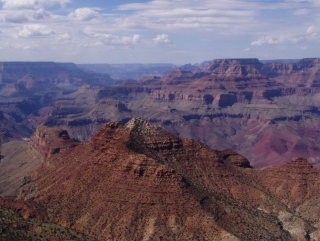 So there you have it. A Final Four of all #1 seeds as well as the three most storied college hoops programs: North Carolina, Kansas, and UCLA. In the historical vein the U of Memphis looks like crude interlopers. How can Keith Lee and Anfernee Hardaway dare go up against the ghosts of Michael Jordan, Wilt Chamberlain, and Lew Alcindor? They can't. Which is why they're our choice. So we can forget about them here at usa-c2c.com. Instead we're going to look at the Super Three Sites, the Pantheon of Parks, the Must Sees of the Must Sees. First up: the Grand Canyon. So there you have it. A Final Four of all #1 seeds as well as the three most storied college hoops programs: North Carolina, Kansas, and UCLA. In the historical vein the U of Memphis looks like crude interlopers. How can Keith Lee and Anfernee Hardaway dare go up against the ghosts of Michael Jordan, Wilt Chamberlain, and Lew Alcindor? They can't. Which is why they're our choice. So we can forget about them here at usa-c2c.com. Instead we're going to look at the Super Three Sites, the Pantheon of Parks, the Must Sees of the Must Sees. First up: the Grand Canyon.
Our friend James actually attended Wilt the Stilt's 100-point game in Hershey, Pa. He was either talking about the game or the Grand Canyon when he said "It's absolutely overwhelming. Your mind cannot comprehend what it is looking at. It is so big and so deep that it feels like an abstract. You say to youself 'I cannot be looking at what I think I am looking at.' And even after you have stared for hours from different vantages and myriad angles it still does not make sense. I couldn't have captured it on camera; it must be seen and experienced. In fact, I forgot my camera!" Actually James didn't say any of that. We did, and it was about the Grand Canyon.
Wilt was impressive but c'mon he was only 7'2". The Grand Canyon is over a mile high in parts and now in the Hualapai Indian section of the canyon (not NPS-run) you can stand over the edge on the $30 million glass Skywalk. The Skywalk adjuts out 70 feet from the canyon edge, the 4,000 feet between you and destiny separated only by five layers of glass. We wouldn't do it either. But if you are interested here's the Hualapai website and a recent New York Times article. Remember to bring you credit cards; a walk on the glass runs at least $74.95.
Click Here to Read More about the more traditional parts of Grand Canyon National Park.
March 28, 2008
Today's Featured Review:
Sweet Sixteen Picks!
OK, so we only went 2 for 4 on Thursday. Much to our chagrin WVU (Friendship Hill NHS) lost to Xavier (William Taft NHS) in Game One. That pompous portly president always finds a way to win! And in Game 4 we learned never to bet against Abe Lincoln even when he's battling a grand daddy of a National Park. We have four picks today so we're making them short but sweet.
Game Five
Davidson University - represented by the Kings Mountain National Military Park
vs.
University of Wisconsin - represented by Ice Age National Scenic Trail and Ice Age National Scientific Reserve
Our pick: Davidson University. Kings Mountain NMP is located about 60 miles from Davidson's idyllic campus and celebrates a decisive American Revolutionary War victory against Loyalist led by British Major Patrick Ferguson. Ferguson liked to dress in a bright red and white uniform. Sounds like Wisconsin to us. We haven't yet been to the Ice Age National Scientific Reserve; it's dire, slow-moving, cold title is enough to scare us away. Much like the turgid style of the Badger hoopsters. We haven't watched them play yet either.
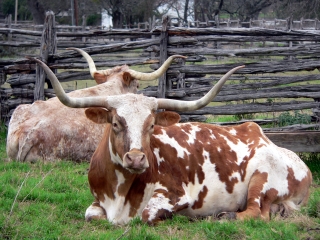 Game Six Game Six
Stanford University - represented by Golden Gate National Recreation Area
vs.
University of Texas at Austin - represented by Lyndon Baines Johnson National Historical Park
Our pick: Texas. "But you guys loved Golden Gate National Recreation Area. It received one of your highest Park Scores. What's the deal?" Well, anyone who has lived in San Francisco or taken classes at Cal-Berkeley doesn't associate Stanford's home - the arid, dusty, Spanish mission feel of Palo Alto - with the restored marshlands, the historic defense structures, redwood groves, cliffside views, and ridgeline hikes Golden Gate NRA. Sure, it's the closest park geographically but it doesn't truly represent Stanford. LBJ NHP, on the other hand, has real live longhorns and is as Texas as Texas gets. This is an easy pick.
Game Eight
Villanova University - represented by Valley Forge National Historical Park
vs.
University of Kansas - represented by Tallgrass Prairie National Preserve
Our pick: Kansas. Tallgrass Prairie N PRES is a lot more beautiful than you would imagine. The college hoops talking heads say Kansas is better than people think. Valley Forge NHP is an American legend maker. A place where suffering, dispair, stubborness, training, and hard work made us strong as a people and as a nation. That stuff is boring. We'll take beautiful wildflowers and ocean-like serenity over tragic stories of frostbite and dysentery any day.
Game Seven
Michigan State University - represented by Sleeping Bear Dunes National Lakeshore
vs.
University of Memphis - represented by Shiloh National Military Park
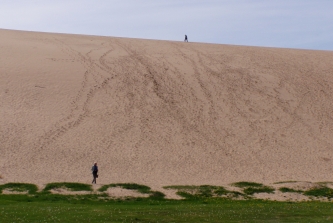 Our pick: Michigan State. Shiloh was an anonymous west Tennessee landscape that for a few days in April, 1862 became an unthinkably bloody killing field and the subject for myriad Civil War books. Sleeping Bear Dunes is an oft-forgotten Park Site located along the Lake Michigan coast. Its centerpiece is a 450-foot high sand dune which determined visitors attempt to scale. We think the Memphis team will be fighting uphill all night so much so that it will seem like they're running in sand. The shifting Michigan State defenses will further compound the Memphis problems and, like at Shiloh, a confusing fog will envelop around the combatants. When the smoke clears, the steadfast dune will remain - standing tall and unconquered. Our pick: Michigan State. Shiloh was an anonymous west Tennessee landscape that for a few days in April, 1862 became an unthinkably bloody killing field and the subject for myriad Civil War books. Sleeping Bear Dunes is an oft-forgotten Park Site located along the Lake Michigan coast. Its centerpiece is a 450-foot high sand dune which determined visitors attempt to scale. We think the Memphis team will be fighting uphill all night so much so that it will seem like they're running in sand. The shifting Michigan State defenses will further compound the Memphis problems and, like at Shiloh, a confusing fog will envelop around the combatants. When the smoke clears, the steadfast dune will remain - standing tall and unconquered.
March 27, 2008
Today's Featured Review:
Sweet Sixteen Picks!
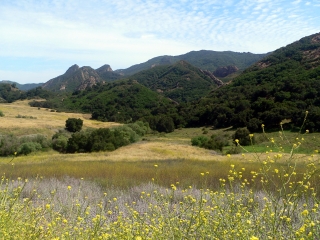 Everybody's got March Madness. Right? Well, I can't say we've caught it here at usa-c2c.com but we're going to do our best to cultivate the fever. Everybody's got March Madness. Right? Well, I can't say we've caught it here at usa-c2c.com but we're going to do our best to cultivate the fever.
Game Three
Western Kentucky University - represented by Mammoth Cave National Park
vs.
University of California at Los Angeles - represented by Santa Monica Mountains National Recreation Area
"Mammoth Cave isn't in western Kentucky," you might be thinking. And, well, it isn't. It's in central Kentucky but then again so is the geographically challenged Western Kentucky University which is located just 20 miles from the cave's entrance. Perhaps some unknown, unexplored section of this underground wonderland passes under the University? You never know.
The Santa Monica Mountains are as iconically L.A. as UCLA's beautiful Westwood campus, it's team's sky blue uniforms, and the famed movie houses that sit just outside the University gates. The Santa Monica Mountains is where they film so many of those movies, where people surf, where stars live, where sunbathing happens, and where the great american road trip ends: the Santa Monica Pier.
Our pick: UCLA. While this matchup may scream upset to the casual National Park fan we're not as willing to go with the underworld cave glitz. Granted, you have the largest cave system in the world vs. an amorphous sprawling Los Angeles park that most of the town's residents don't even know is there but that L.A. park is so diverse, so beautiful, and so much fun. Did they film M*A*S*H at Mammoth Cave? Can you windsurf at Mammoth Cave? Are their California girls at Mammoth Cave? Case closed. Pick made.
Game Four
University of Louisville - represented by Abraham Lincoln Birthplace National Historic Site and Lincoln Boyhood Home National Memorial
vs.
University of Tennessee - represented by Great Smoky Mountains National Park
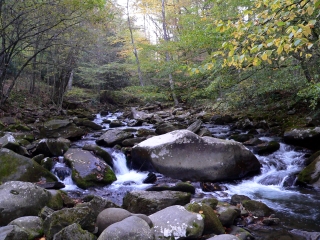 No one would ever confuse Louisville's slippery head coach Rick Pitino with the great emancipator Abe Lincoln. No one except geography and the National Park System who have inconveniently placed two Honest Abe venerations equidistant from Dishonest Rick's current college coaching gig. No one would ever confuse Louisville's slippery head coach Rick Pitino with the great emancipator Abe Lincoln. No one except geography and the National Park System who have inconveniently placed two Honest Abe venerations equidistant from Dishonest Rick's current college coaching gig.
The underrated college town of Knoxville, Tennessee could be used as a gateway city to the East's grandest wilderness area: the Great Smoky Mountains National Park. It's located just 35 miles away and it's much more compelling a spot than the insane commercialization of Pigeon Forge and Sevierville. The Smokies themselves are supernaturally beautiful and the Park is a hiker's paradise despite the huge crowds and increasing air pollution.
Our pick: Tennessee in a romp. Lincoln's parks are nice but they definitely have a shady sheen about them. The Birthplace Site's centerpiece is a log cabin which a turn-of-the-century snake oil salesman-type (like Pitino) claimed to have been the Abe's cabin. It wasn't. And note the National Memorial designation on the Boyhood Home Site. That means, in bureaucratic NPS code, that historians aren't 100% sure that anything of merit ever happened there. The Great Smoky Mountains, on the other hand, is an International Biosphere Reserve, a World Heritage Site, boasts over 500,000 acres and contains more plant species than the entire continent of Europe. Go Vols!
March 26, 2008
Today's Featured Review:
Sweet Sixteen Picks!
Game One
University of West Virginia - represented by Friendship Hill National Historic Site
vs.
Xavier University - represented by William Howard Taft National Historic Site
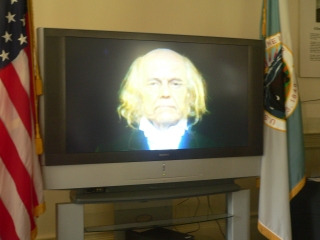 On paper this looks like a pretty boring matchup that no one really cares about and for the most part it is. Friendship Hill NHS may be located in Pennsylvania but it is just 30 miles north of the WVU campus. The other West Virginia NPS sites are much farther away. Friendship Hill is a strange out-of-the-way country mansion dedicated to the life of Albert Gallatin, a man who helped design and oversee the federal monetary system and economic philosophy of the young United States of America. The site's coup de grace is a video tape of Gallatin's severed head telling his life story Swiss accent and all. On paper this looks like a pretty boring matchup that no one really cares about and for the most part it is. Friendship Hill NHS may be located in Pennsylvania but it is just 30 miles north of the WVU campus. The other West Virginia NPS sites are much farther away. Friendship Hill is a strange out-of-the-way country mansion dedicated to the life of Albert Gallatin, a man who helped design and oversee the federal monetary system and economic philosophy of the young United States of America. The site's coup de grace is a video tape of Gallatin's severed head telling his life story Swiss accent and all.
The Taft house is also no stranger to strange exhibits. Located in Cincinnati, Ohio (just like Xavier) the museum is dedicated to one of America's most loathsome presidents, Williams Howard Taft, and his many political scions. Its odd adornment is a full-sized animatronic Charles Phelps Taft II, a/k/a Mr. Cincinnati and William Howard's son, adorned in outdoors gear and armed with a fly fishing rod. Charlie presumably tells his family's story although he was broken during our visit.
Our pick: West Virginia by a country mile. Perhaps even one of those many country miles we drove along on our way to Friendship Hill. This choice is more a case of the Taft site being so poor than Friendship Hill being desirable. Go Mountaineers! We might even choose to represent you with super fun in-state site like the New River Gorge National River or the Gauley National Recreation Area if you make it to the next round.
Game Two
Washington State University - represented by the Whitman Mission National Historic Site
vs.
University of North Carolina - represented by Guilford Courthouse National Military Park
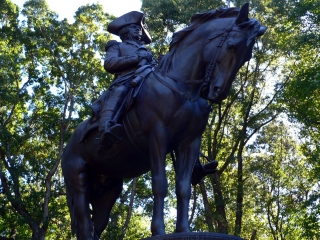 Washington State University plays a slow deliberate methodical style of basketball that aims to impose their will on opponenets. We're assuming that the Presbyterian missionaries Marcus and Narcissa Whitman used a similar style of tactic on southeastern Washington's Cayuse Indians hoping to turn them towards the goodness of Christianity. But in the end the Whitman's were massacred, their adopted children were slaughtered, and the mission failed. Most people think this is what's going to happen to the Cougars on Thursday night. Washington State University plays a slow deliberate methodical style of basketball that aims to impose their will on opponenets. We're assuming that the Presbyterian missionaries Marcus and Narcissa Whitman used a similar style of tactic on southeastern Washington's Cayuse Indians hoping to turn them towards the goodness of Christianity. But in the end the Whitman's were massacred, their adopted children were slaughtered, and the mission failed. Most people think this is what's going to happen to the Cougars on Thursday night.
Greensboro, N.C.'s Guilford Courthouse was the site of a very important Revolutionary War battle. The American forces didn't exactly win but they inflicted so many losses on their redcoated enemies that the Brits were forced into surrending the War seven months later at Yorktown.
Our pick: University of North Carolina in a squeaker. This was a tough one. For starters, both sites honorees actually lose their respective fights. How can you pick a winner there? To make a choice we called on our experience in the competing schools' respective college towns. Pullman, Wash. was charming, quaint, and immediately forgettable. We enjoyed a nice mug of coffee but the campus and downtown areas were easily overshadowed by its sister city Moscow, Idaho. Chapel Hill, N.C. on the other hand was one big barrel of fun. Restaurants, bars, beautiful people, and a perfect college setting.
Tomorrow we look at the Thursday evening games.
March 24, 2008
Today's Featured Review:
Cape Cod National Seashore
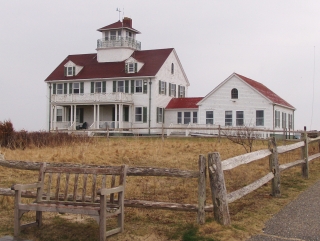 Monday was St. Patrick's Day and what better way to celebrate than honoring our most celebrated Irish-American hero: John F. Kennedy. During our trip, we visited a number of sites that celebrated the legacy of our 35th president. On Monday we looked at his Brookline, Massachusetts birthplace, home of John F. Kennedy National Historic Site and on Wednesday we traveled to Boston's southern outskirts and the John F. Kennedy Presidential Library and Museum. Today we stay in Massachusetts but move away from Boston, onto the Cape, and to Cape Cod National Seashore. Monday was St. Patrick's Day and what better way to celebrate than honoring our most celebrated Irish-American hero: John F. Kennedy. During our trip, we visited a number of sites that celebrated the legacy of our 35th president. On Monday we looked at his Brookline, Massachusetts birthplace, home of John F. Kennedy National Historic Site and on Wednesday we traveled to Boston's southern outskirts and the John F. Kennedy Presidential Library and Museum. Today we stay in Massachusetts but move away from Boston, onto the Cape, and to Cape Cod National Seashore.
Cape Cod contains perhaps the most fabled JFK home: Hyannis Port's Kennedy Compound. But his Nantucket Sound-facing residence isn't the reason we're associating the National Seashore with President Kennedy; Hyannis Port isn't really near the Park's boundaries. We relate Cape Cod to JFK because it was one of the first National Park Areas he established while president. Kennedy knew the Cape's beauty, he knew its barrier island ecological necessity and he knew that if growth on the Cape weren't stunted then the area would become an over-populated over-commercialized mess.
So on August 7, 1961 he authorized Cape Cod to be a part of the National Park System. At that time the only other National Park Service-protected National Seashore was Cape Hatteras in North Carolina. But partly because of JFK's Cape Cod foresight more barrier island seashores located near population centers would soon become National Park Areas: Point Reyes National Seashore and Padre Island National Seashore, both authorized in 1962; Fire Island National Seashore authorized in 1964; and Assateague Island National Seashore authorized in 1965. More National Seashores would follow in the 1970s, a veritable wave of ecological protection.
We thank John F. Kennedy for serving as the catalyst for the National Seashore movement. Because of him Cape Cod still looks beautiful.
Click Here to Read More about Cape Cod National Seashore.
March 19, 2008
Today's Featured Review:
John F. Kennedy National Historic Site
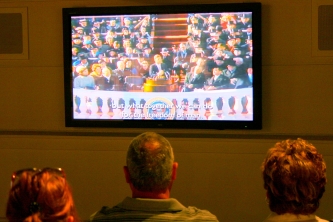 The memory of JFK and his mythic life still holds powerful sway in New England. The 45 years that have passed since his assassination are reduced to none once you step into his Library. The crowds' lingering love for Kennedy makes the Museum a very emotional, somber and hero-affirming place. The memory of JFK and his mythic life still holds powerful sway in New England. The 45 years that have passed since his assassination are reduced to none once you step into his Library. The crowds' lingering love for Kennedy makes the Museum a very emotional, somber and hero-affirming place.
The Museum does a terrific job of explaining and evoking Camelot, the romance of a young, charming and handsome President and in the promise that hope brought a modern nation.
We enjoyed being transported back in time through I.M. Pei's alternate universe spaceship. Back to a time of heroes and legends and of hope and dreams. Back to a time when greatness was the goal, when the future was a part of the plan, when fear was forgotten and dreams were met without cynicism.
Click Here to Read More about John F. Kennedy National Historic Site.
March 17, 2008
Today's Featured Review:
John F. Kennedy National Historic Site
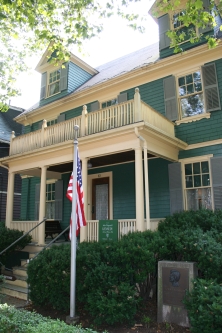
The Site is a memoriam designed and dedicated by JFK’s mother, Rose Kennedy, consisting almost entirely of items used by her President son during his childhood. The furnishings are all Kennedy originals. Rose retrieved from basements and relatives for the sole purpose of reconstructing the House exactly as she had remembered it while living there with young Jack.
Jack's birth, his sickly youth, his crowded house and stern but loving parental hands serve as the backdrop to the larger story told by Rose and the National Park Service (NPS). It is the story of early 20th Century immigrants, of hard work, of getting your children ahead in life and ultimately of the American dream.
But don't go there this week because the Site hasn't opened yet for business. Check back in April.
Click Here to Read More about John F. Kennedy National Historic Site.
March 12, 2008
Today's Featured Review:
Glacier National Park
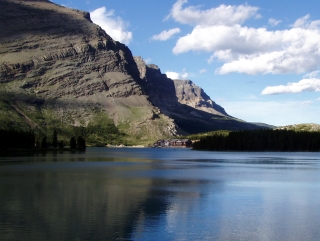 As we continue our Sickness Week some of you dear readers might be saying, "Is usa-c2c.com sick? We haven't seen a post in ages." No, we are not sick; we're just moving a little bit slowly. But when we were sick, about two weeks ago we did run a high fever. Which is sort of like what's going on at Glacier National Park. Only Glacier National Park doesn't have insurance and is not going to get better. As we continue our Sickness Week some of you dear readers might be saying, "Is usa-c2c.com sick? We haven't seen a post in ages." No, we are not sick; we're just moving a little bit slowly. But when we were sick, about two weeks ago we did run a high fever. Which is sort of like what's going on at Glacier National Park. Only Glacier National Park doesn't have insurance and is not going to get better.
The park’s namesakes will not be there forever. As we were hiking to the Grinnell Glacier, one of the largest remaining ice floes in the park, we passed a set of young geologists who had kayaked out to the base of the glacier to measure it. It has shrunk almost 300% from 2001 to our visit in 2004. At this rate, Glacier National Park is anticipating its final glaciers to melt within 25 to 40 years. There is a bit of urgency if majestic ice forms are what you aiming to see.
No glaciers at Glacier National Park? Get used to it because it's going to happen. Think about it, the next generation of children will visit the Park believing it got its name because it was formed by glaciers not because it has glaciers. Which will make it pretty much like every bit of land north of the 42nd parallel. Well, except for the dramatic ridges, abundant wildlife, and breathtaking landscape.
The culprit is, of course, what numerous American media outlets and countless citizens defensively insist isn't supposed be happening: global warming. Problem is, it helps little for humans to be defensive. We may have caused this looming calamity but at the end of the day it's our place on earth that is at risk. The planet, its myriad lifeforms, and its stunning scenery are all going to be fine in the long run. We are the ones who are endangering ourselves, making our sustainable life on earth more precarious by the day.
So what can we do? Firstly, we can stop living in denial. Secondly, we can stop rolling our eyes and scoffing at people who are living in denial. It's your self-interest that's at stake. After that a quick google search turns up many organizations with stop global warming: www.fightglobalwarming.com; www.stopglobalwarming,org; www.globalgreen.org; and www.sierraclub.org. The Sierra Club also includes a page with ten things you can do to cure global warming. Most of their suggestions sound pretty easy to us. If anyone else has any suggested email links just email them to us at gabandmichael@usa-c2c.com. Thanks!
Click Here to Read More about Glacier National Park.
March 5, 2008
Today's Featured Review:
Everglades National Park (Gulf Coast)
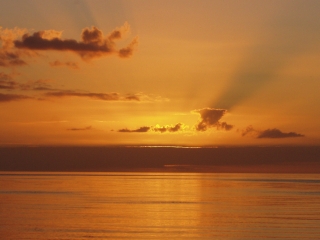 On Monday we segued from President's Week into Sickness Week with Indiana's George Rogers Clark National Historical Park. If that makes no sense at all then just scroll down for our explanation. Very well, let's move on. 69-year old Presidents who give two-and-a-half hour inaugural speeches don't represent all the National Parks that can be sick. Not at all. Some Parks are sick themselves and need help. Case in point: the Everglades. On Monday we segued from President's Week into Sickness Week with Indiana's George Rogers Clark National Historical Park. If that makes no sense at all then just scroll down for our explanation. Very well, let's move on. 69-year old Presidents who give two-and-a-half hour inaugural speeches don't represent all the National Parks that can be sick. Not at all. Some Parks are sick themselves and need help. Case in point: the Everglades.
South Florida is a very young land mass, appearing anywhere from 6,000 to 8,000 years ago, a veritable newborn. Native Americans are thought to have crossed the Alaskan land bridge over 10,000 years ago, predating the Everglades. Since their creation, the shallow Everglades slowly meandered on its way to the Florida Bay. Human interaction was limited to a few Indian tribes until the turn of the century when full-scale settlement began in South Florida.
Since then, humans have drained the Everglades, disrupted and redistributed the water flow with canals, dumped sugar cane runoff and untold other waste products into the “River of Grass” and demolished and filled portions for development. The Everglades are in critical condition and there are no plausible solutions, only stopgap measures. Everglades NP is our most endangered National Park.
What can you do to learn more? Picking up Marjory Stoneman Douglas's ecology classic The Everglades: River of Grass would be a good start or you could surf over to the website of the organization she began: the Friends of the Everglades. There are plenty more links there where you can learn about what you can do to save an American treasure.
Click Here to Read More about Everglades National Park.
March 3, 2008
Today's Featured Review:
George Rogers Clark National Historical Park
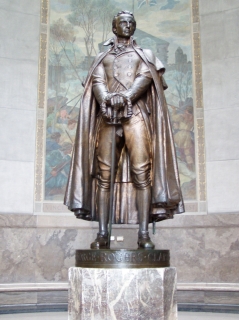 So last week you're reading usa-c2c.com. There's a post on Monday about Jimmy Carter. It seems that their President's Day week has continued into two President's Day weeks. But you come back Wednesday...still Jimmy. Then Thursday...still Jimmy. Even Friday...still Jimmy. What has happened? Have they forgotten about me, the dear reader? So last week you're reading usa-c2c.com. There's a post on Monday about Jimmy Carter. It seems that their President's Day week has continued into two President's Day weeks. But you come back Wednesday...still Jimmy. Then Thursday...still Jimmy. Even Friday...still Jimmy. What has happened? Have they forgotten about me, the dear reader?
No, not at all. The intrepid usa-c2c.com staff was sick. Very sick. So sick we couldn't open up our computers sick. But we're better now. Better enough to close out our President's Day week and segue it into a new theme: illness-related Parks. First up is Vincennes, Indiana's George Rogers Clark National Historical Park.
Hold up? Was George Rogers Clark a President? Was he especially sickly? No and perhaps sick with power and madness. But this post isn't about good ol' GRC, it's about Vincennes, Indiana's other favorite son: William Henry Harrison, the ninth POTUS.
Famously, WHH didn't last very long as Commander-in-Chief. He entered la maison blanche 157 years ago tomorrow, March 4, 1841, and was dead a month later. His crime against the unforgiving fates was a two-hour long inaugural speech...in cold rain...without a coat. His subsequent mild cold turned into pneumonia which turned into our country's first dead president, WHH, and our first accidental president, John Tyler.
So what does WHH have to do with GRC? Nothing really except they both enjoyed fighting Indians and they both have ties to Vincennes. GRC's Park remembers his 1779 victory at Vincennes' Fort Sackville. V Town became the capital of Indian Territory in 1800 and WHH was its first governor. For the next 12 years William would fight scores of Indians thus making Indiana safe for inclusion into these United States.
But legend has it that his victories came with a price: Tecumseh's curse. Shawnee leader Tecumseh, perhaps apocryphally, manifested his word that any president elected in a year ending in zero would die in office. Did the curse come true? You betcha. WHH was the first victim and until Ronald Reagan's fortuitous 1981 bullet dodging, the curse had been six for six. W has eluded the doom thus far but six for eight ain't bad.
Click Here to Read More about George Rogers Clark National Historical Park.
February 25, 2008
Today's Featured Review:
Jimmy Carter National Historic Site
It's that time of year again...President's Day and President's Week at usa-c2c.com! We have been counting down the days to when we can tell you about some of our favorite U.S. President-related National Park Sites and Presidential Libraries. If you don't like waiting for our suggestions then use the above pulldown to find your presidential way. First up was the long reviled and somewhat misunderstood Herbert Hoover. On Wednesday we looked at the ever longer reviled and not at all misunderstood Andrew Johnson. Today we look at a president who was much dearer to our hearts: Jimmy Carter.
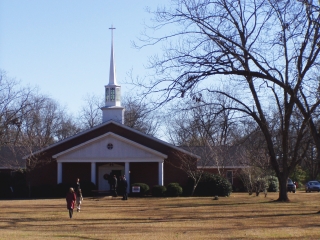 Why rise at 5 a.m. to drive across Georgia from Macon to Plains, population 700? Among Plains’ residents are Rossalyn and Jimmy Carter, and the former President and Nobel Peace Prize winner was teaching Sunday school that morning. Why rise at 5 a.m. to drive across Georgia from Macon to Plains, population 700? Among Plains’ residents are Rossalyn and Jimmy Carter, and the former President and Nobel Peace Prize winner was teaching Sunday school that morning.
We were thrilled and excited, but we had doubts. Would we be welcome in this small town? The Maranatha Baptist Church is tiny, with room for only 300. Would there be room? It is not our denomination. Is it ok if we attend?
We arrived at the Church at 8 am. The Greeter smiled, laughed and erased our worries, The Secret Servicemen took our picture to ensure that our camera really was a camera and then urged us in, “you never know when the buses will show up.” We were fine.
Once seated inside, the pews filled around us, save the few cordoned off for active members. Before we knew it, a quiet man had slipped through a side door. Jimmy Carter was standing just six pews away.
He asked where we were all from. California, Uganda, Poland, Germany, Florida. People from dozens of countries and states had made the same pilgrimage. Gab eagerly yelled out Pennsylvania. Jimmy’s response, his warm wide smile of acknowledgment, made us all feel loved.
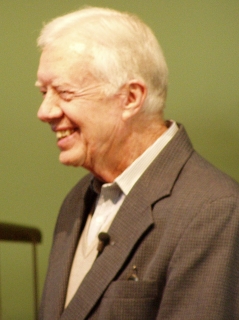 His lesson’s topic was Joseph’s part in the Christmas story, but his lesson invoked elections in Mozambique, vacationing with his grandchildren and a profound biblical knowledge. We felt blessed and thankful for the teachings of such a pious, humble and great man. His lesson’s topic was Joseph’s part in the Christmas story, but his lesson invoked elections in Mozambique, vacationing with his grandchildren and a profound biblical knowledge. We felt blessed and thankful for the teachings of such a pious, humble and great man.
Jimmy left saying, almost apologetically, that in two weeks he would be unable to teach in Plains. He was going to Palestine to oversee an election. He reminded us of what Anwar Sadat told him at Camp David that “regardless of religion, we are all sons of Abraham.” We must learn to live together.
Click Here to Read More about Jimmy Carter National Historic Site.
February 20, 2008
Today's Featured Review:
Andrew Johnson National Historic Site
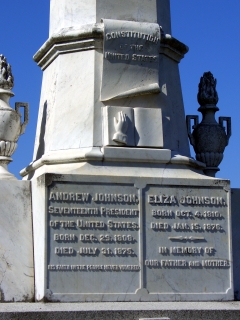 Andrew Johnson's inclusion in the National Park System proves one thing: the NPS is an equal opportunity honorer. Andrew Johnson is one of those people that no one has anything nice to say about. By all accounts he was cantankerous, a violent drunkard, a miserable sot, an utter failure at President, and, to top it all off, not a particularly talented man. Andrew Johnson's inclusion in the National Park System proves one thing: the NPS is an equal opportunity honorer. Andrew Johnson is one of those people that no one has anything nice to say about. By all accounts he was cantankerous, a violent drunkard, a miserable sot, an utter failure at President, and, to top it all off, not a particularly talented man.
Unlike the hated Herbert Hoover, Johnson never made any money (he was a tailor) and he never donated anything or helped any poor struggling war-torn masses. Quite the opposite in fact. While working as Tennessee military governor during the Civil War he was known for his vicious ruthlessness toward the Confederate population of his adopted state. Johnson also had limited knowledge of the English language - he learned to read and write well into his twenties - whereas Hoover knew multiple languages and was an adept translator.
Personal differences aside they both couldn't cut it as Commander-in-Chief. To Hoover's credit he wasn't impeached (like Johnson) and did actually seek a second-term nomination. To be fair, neither had much of a chance for success. Hoover's Great Depression and Johnson's post-Civil War Reconstruction were situations where even George Washington might have failed. However, the difficulty of Johnson's situation should not override his poor responses.
His leadership style was worse than anyone could have imagined, despite the fact that many of his ideas were prudent, fair and justified. Johnson refused to agree with Congress about anything. He vetoed every bill that came his way, angering both parties and all people while simultaneously (and perhaps correctly) sheathing himself in the holy virtue of the U.S. Constitution. And for that he gets a National Park Site. Sign me up for President!
Click Here to Read More about Andrew Johnson National Historic Site.
February 18, 2008
Today's Featured Review:
Herbert Hoover National Historic Site
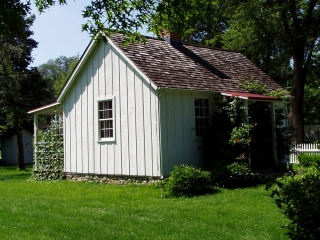 Was Hoover he a great president? Not at all. Was he responsible for the Great Depression? Not nearly as much as he has been credited. In fact, the lessons we learned at the Herbert Hoover NHS and the adjacent Herbert Hoover Presidential Library were very surprising. Hoover grew up orphaned and very poor. He entered Stanford University in 1891, that venerated school's first year of existence. Hoover received a degree in geology; surely a unique specialty among his presidential brethren. Was Hoover he a great president? Not at all. Was he responsible for the Great Depression? Not nearly as much as he has been credited. In fact, the lessons we learned at the Herbert Hoover NHS and the adjacent Herbert Hoover Presidential Library were very surprising. Hoover grew up orphaned and very poor. He entered Stanford University in 1891, that venerated school's first year of existence. Hoover received a degree in geology; surely a unique specialty among his presidential brethren.
Hoover didn't teach with his degree nor did he go directly into politics. Instead he traveled the world working as a mining engineer whose speciality was finding gold, silver, zinc, and other precious metals. And find he did. By the time he turned 30 Hoover had built up considerable wealth given his uncanny ability to unearth metals. In the meantime, while on many Pacific Ocean-crossing trips he and his wife mastered numerous languages, Mandarin Chinese included, and authored the first English translation of the 16th-century mining bible De re metallica.
When the Great War began in 1914 Hoover directed his efforts towards humanitarian work, the most notable being a widespread and successful effort to feed war-ravaged Belgium. Hoover's magnanimous humanitarianism continued throughout the 1920's while he was U.S. Secretary of Commerce. So what went wrong? How could someone with so much experience in feeding people and aiding communities post-disaster be such a failure during the Great Depression? The short answer is that all of Hoover pre-Depression efforts depended on capital from private interests; Hoover didn't believe in spending the government's money. His Great Depression remedies while solid in theory relied on private donations which, despite many promises, never came.
Click Here to Read More about Herbert Hoover National Historic Site.
February 14, 2008
Today's Featured Review:
Carter G. Woodson House National Historic Site

Happy February. The month that has become synonomous with Black History. We wonder what the founder of Black History Month would think about his creation's longevity and lasting importance. He would probably be brimming with pride.
Who created Black History Month, you ask?
Meet the latest addition to the National Park Service family and the Site that honors his legacy: Carter G. Woodson National Historic Site.
Currently, only an official NPS marker and a No Trespassing sign are up at the Site's NW Washington D.C. location. To find out more about this distinguished historian you have to walk a few blocks down the road to the Mary McLeod Bethune Council House NHS.
While the historical significance of some Park Service acquisitions are dubious at best, this purchase feels long overdue. What we learned about Mr. Woodson at the Bethune Council House left us a little ashamed that we knew so little about the man who changed the course of history and how it is taught.
The Woodson House NHS is closed to the public "pending restoration." The Park Service isn't even speculating when it will be open. We hope we don't have to wait too long.
Click here for the full review.
Use the pulldown menu just below to further explore some of the National Park Service's other Black History Month-related sites. We will be highlighting some of our favorites in the coming weeks so stay tuned.
February 11, 2008
Today's Featured Review:
Steamtown National Historic Site
 Wilkes Barre-Scranton, Pennsylvania isn't known for its trains. George Inness’s classic American landscape painting “The Lackawanna Valley” profiled the areas steamtrains but his art was more allegorical than literal. The Scranton Yard was never a particularly central or important cog in our nation’s railroad network. What is Wilkes Barre-Scranton known for? Anthracite coal. Wilkes Barre-Scranton, Pennsylvania isn't known for its trains. George Inness’s classic American landscape painting “The Lackawanna Valley” profiled the areas steamtrains but his art was more allegorical than literal. The Scranton Yard was never a particularly central or important cog in our nation’s railroad network. What is Wilkes Barre-Scranton known for? Anthracite coal.
Today marks an odd anniversary for the dirty black heat-bearing fossil fuel. On February 11, 1808 a Wilkes Barre tavern owner, Jesse Fell, decided to try burning anthracite coal in his indoor open-grate stove. The conventional wisdom was that indoor anthracite burning was too difficult and too dangerous for household use. So what compelled him to try it out? Visionary or lucky fool? You decide.
Remember, Fell ran and lived in his tavern. In the early 19th century taverns also included lodgers. On that 1808 February 11th he had guests. Here's a quote from a neighbor, "Late in the afternoon (Mr. Fell) brought (his experimental stove)home, and set it up with brick, in the fireplace of the bar-room. By evening he had kindled in it, with oak wood, one of the best coal fires. The interest this excited, and the many visits of curious neighbors, anxious to see a stone-coal fire, were also well remembered."
Another remembrance slightly contradicts this story stating that "Fell started the fire at night to avoid curious questions from his guests and awoke the next morning to discover the coals still burning." He wanted to avoid questions from his guests! Imagine you're staying at a hotel and they decide, on a whim, to change their heating in the middle of the night to experimental nuclear fission power or something even more unknown and unsteady. Yikes! Here's a link to the Pennsylvania historical marker so you know we're not making this story up.
Steamtown NHS doesn't have any outrageous and historically important stories like Mr. Fell's. It just has a few trains with their own dubious history. (They're not even from Scranton. They're Canadian!) Although it wouldn't have been as sexy, we wish the Park Service would have chosen to honor Scranton's history with an anthracite coal-related Park Site rather than with one honoring foreign trains.
Click Here to Read More about the Steamtown National Historic Site.
February 8, 2008
Today's Featured Review:
Cane River Creole National Historical Park
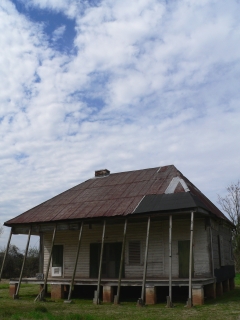 Tadeusz Kosciuszko and Ronald Reagan aren't the only beloved American Aquarians. We continue usa-c2c.com birthday week honoring a lesser known American hero: Kate Chopin. Tadeusz Kosciuszko and Ronald Reagan aren't the only beloved American Aquarians. We continue usa-c2c.com birthday week honoring a lesser known American hero: Kate Chopin.
Who is Kate Chopin? Is there a Frederic Chopin-Poland-Kosciuszko connection involved here? Not at all. Kate was not a musician, not Polish (she was Irish), and not a Revolutionary War hero. She was a different type of American Revolutionary. She was a writer, a short storyteller, and one of America's first great female and feminist writers.
The wikipedia states that her most famous novel, 1899's The Awakening, was met coolly by critics because of its unwholesome lead female character and because of its sexual openness. Michael was assigned the book in University, he believes, but never got around to reading it. While this might not make for a good story or cogent discussion it does reveal that the book has cemented its place in the American literary canon.
So why the Cane River Creole National Historical Park? Kate Chopin lived much of her life in the Natchitoches, Louisiana, Cane River area. Many of her stories utilize this setting as well. There is nothing on the Park's website concerning Ms. Chopin but that doesn't mean a trip to the Site won't contextualize her stories' settings and local character.
We didn't have the best of times at Cane River Creole National Historical Park during our February 2005 visit. The entire site felt like a doomed work in progress. We hope and believe that things have changed since then. If you find yourself in north central Louisiana, stop in and ask about Kate Chopin.
Click Here to Read More about the Cane River Creole National Historical Park.
February 6, 2008
Today's Featured Review:
Ronald Reagan Presidential Library
 Tadeusz Kosciuszko isn't the only beloved American hero who challenged the Russians that's celebrating a birthday this week. That's right, today would have Ronald Reagan's 97th birthday. His Dixon, Illinois boyhood home isn't a National Park Site yet although its pending Park status was established by law six years ago today. Our usa-c2c trip didn't take us to just National Park Sites, we also visited all but one Presidential Library. Reagan Simi Valley memorial was not the exception. Tadeusz Kosciuszko isn't the only beloved American hero who challenged the Russians that's celebrating a birthday this week. That's right, today would have Ronald Reagan's 97th birthday. His Dixon, Illinois boyhood home isn't a National Park Site yet although its pending Park status was established by law six years ago today. Our usa-c2c trip didn't take us to just National Park Sites, we also visited all but one Presidential Library. Reagan Simi Valley memorial was not the exception.
Do Reagan (and his library) and Kosciuszko (and his house) share anything more in common? Nothing whatsoever. Kosciuszko's Philly home is one of the least visited National Park Sites with about 16 visitors per day. At the Reagan library, you will probably be in line behind 16 other people waiting for your ticket. And if you pick the right day (May 3, 2007 or January 30, 2008 for example) those 16 people might all be vying for the Republican Presidential nomination.
Yes, McCain, Huckabee, Romney, et al love debating near Reagan's final resting place. Who can blame them? The Site is situated on a hilltop above California’s Simi Valley and the Library’s backyard offers unobstructed views of the Santa Monica mountain range, its rolling hills and the palatial estates nestled in its valleys.
They also might keep coming back to see the new Air Force One exhibit. The Reagan library doesn't try to recreate the President's plane Disney style a la a few other Presidential Libraries. Nosiree. They built an ersatz hangar, procured a decomissioned Air Force One, parked the famed flying machine in said hangar, and opened it up for tours. It's the closest any civilian, except Harrison Ford, may ever get. As a result, the Library's entry fee has risen from $7 to $12 per person. We are sure it's worth it.
Click Here to Read More about the Ronald Reagan Presidential Library.
February 4, 2008
Today's Featured Review:
Thaddeus Kosciuszko National Memorial
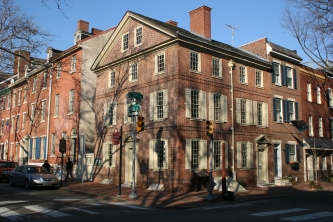 Today is February 4th, a/k/a Tadeusz Kosciuszko's Birthday. Sure, we mentioned him everyday last week but that matters little. If you thought we wouldn't honor our great Polish hero on his 262nd birthday than you would have been wrong. Today is February 4th, a/k/a Tadeusz Kosciuszko's Birthday. Sure, we mentioned him everyday last week but that matters little. If you thought we wouldn't honor our great Polish hero on his 262nd birthday than you would have been wrong.
Why should we continue to honor him? Well, after an early Revolutionary War setback, our dashing Polish Patriot never lost another fight on American soil, unlike New England's kicker Stephen Gostkowski. You might say that poor Stephen never got a chance, that during the third quarter on 4th and 11 he should have been able to try that 49-yard field goal. We say that now he knows what it was like for gallant Tadeusz. During the 1775 Battle of Fort Ticonderoga he beseeched his generals "Build fortifications here! The British can reach this point with cannons!" His generals unwisely ignored him and the battle was lost.
Tadeusz never made it to the warm sunny climes of Arizona; we're sure his tan would have been spectacular. Instead he chose a small humble home in Old City Philadelphia. Given his Philly roots there's no way he could have been rooting for the Giants. Nevertheless we are sure he would have admired New York's stellar defensive tactics.
Defense was Tadeusz's specialty! His tactics, engineering, design, and artistry were all pure genius. The best this country has ever seen. You might counter with fellow Slav and defensive genius Bill Belichick? Let's see. First of all, Kosciuszko never needed any videotape to know what the British were doing. We admit that he too might have had spies but he also had to counteract a more menacing traitor. Benedict Arnold vs. Patriots' videotaping assistant Matt Walsh. You decide.
Tadeusz did retreat pretty quickly at Fort Ticonderoga but he had to...he was facing cannon fire! What was Belichick's Super Bowl exit excuse? Deadly confetti? Here are some more reasons. Tadeusz was always impeccably dressed. He wrote the Polish Consitution. He successfully defended his motherland against Russia. And even then his Polish King betrayed him, surrendered to Russia, and Tadeusz was imprisoned in Siberia. Siberia! Where's Belichick headed to after Super Bowl XLII, a McMansion in Boca Raton? His yacht in the Keys? Sometimes life just isn't fair.
So our conclusion and message to Michael's beloved Los Angeles (hopefully soon) Rams is fire Jim Haslett, exhume Tadeusz, clone his DNA, and thusly create the greatest defensive football mind known to man. Super Bowl XLIII here we come.
Click Here to Read More about the Tadeusz Kosciuszko National Memorial.
January 31, 2008
Today's Featured Review:
Upper Delaware Scenic and Recreational River
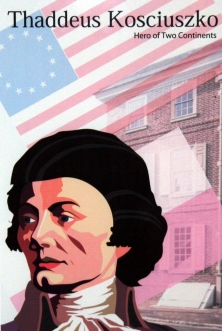 Last Monday (scroll down) we professed our love (yet again) for Poland's brave Tadeusz Kosciuszko. This Monday it will be that time of year again: Kosciuszko's Birthday! He would have been 262 and would still surely be charming the ladies. Last Monday (scroll down) we professed our love (yet again) for Poland's brave Tadeusz Kosciuszko. This Monday it will be that time of year again: Kosciuszko's Birthday! He would have been 262 and would still surely be charming the ladies.
The Polish Cultural Center in Philadelphia is even hosting a party this Saturday at our hero's 3rd and Pine Street former home and current National Park Site. We talk about our Kosciuszko review so much that we felt guilty about featuring him again. So instead we're highlighting another Pennsylvania transplant who's celebrating his birthday: Zane Gray.
Zane Gray was one of America's first superstar authors. His exciting tales of doomed romance, scheming Christians and Mormons, antiheroic cowboys, sassy women, and angry Indians made him a fortune, delighted generations, and were essential in shaping the mythical American West.
Gray wrote most of his epic Westerns in his Delaware River facing Lackawaxen, Pennsylvania home. This house is now a National Park Service museum that examines his life and works. We were unable to tour the house in 2006 because of that summer's serious flooding. The Museum has reopened but don't try visiting now; the doors are only open from Memorial Day to Labor Day.
The moral of that story is: head to Philly to celebrate Kosciuszko Day because there is no Zane Grey Day in Lackawaxen. Or something like that.
Click Here to Read More about the Upper Delaware.
Click Here to Read More about the Tadeusz Kosciuszko National Memorial.
January 28, 2008
Today's Featured Review:
Gettysburg National Military Park
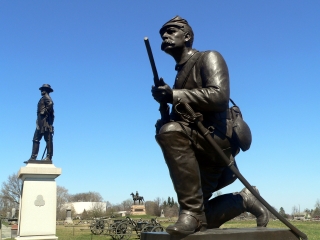 When we wrote about Gettysburg National Military Park in 2006, we admitted that it was indeed an "iconic American destination," but warned you to wait until the new $100M Visitors Center opened in 2007-2008 to visit since the its "current infrastructure matches neither the area’s historical prominence nor its 2M people per year tourist influx." When we wrote about Gettysburg National Military Park in 2006, we admitted that it was indeed an "iconic American destination," but warned you to wait until the new $100M Visitors Center opened in 2007-2008 to visit since the its "current infrastructure matches neither the area’s historical prominence nor its 2M people per year tourist influx."
Since our review, a decision has been made on the proposed Gettysburg casino (no go), and the closed-for-much-needed renovations Battle of Gettysburg cyclorama is one step closer to opening.
Our local paper announced this week that "A grand opening celebration for the restored Gettysburg Cyclorama painting and the Gettysburg National Military Park visitor center/museum will take place in September."
We also learned from the paper that a team of Polish experts were flown in from Gab's former residence Wroclaw to head the cyclorama's restoration. What do Poles know about cycloramas?
A lot.
Ryszard Wojtowicz, his wife, Danuta Drabik-Wojtowicz, sister, Wiktoria Wojtowicz-Janowska, and Wieslaw Kowalczyk worked on the preservation of Wroclaw's own cyclorama, just as epic in size and relevance to its companion in Gettysburg, just as dilapidated before Wojtowicz's team got to it. Wroclaw's cyclorama, known to many simply as "The Panorama" depicts the Battle of Raclawice, "a famous episode of the Kosciuszko Insurrection, a heroic but in the end fallen attempt to defend Polish independence."
(You already know how we feel about Kosciuszko.)
So, September's grand openings will certainly necessitate a new visit and a new review to Gettysburg. In the meantime, click here to read what we wrote in 2006.
January 23, 2008
Today's Featured Review:
Fort Laramie National Historic Site

The theme this week at usa-c2c.com is forts. Why is that? A cold, windy spell has hit our fair city and we've been stuck inside. We've been under siege. The shades are all drawn to block out the cold, we're bundled up in blankets, we're worried about what's outside, and we don't feel good about it. Not exactly sure what this has to do with forts but it made sense at the time. First up is Wyoming's Fort Laramie.
Perhaps the most fabled of all the American West frontier forts. Fort Laramie played a vital part in every stage of the West’s development. The Site exists of a mixture of the Fort’s original buildings. The NPS have beautifully restored and refurbished some structures while it has let other lie in ruin with only their stone shells in view.
History comes alive at Fort Laramie NHS. The mix of reconstructed structure and buildings standing in ruin is an inspired touch. Even though the history is only 150-odd years old, we got a feeling similar to the ruins of ancient Rome and Greece. Fort Laramie is a time that has past, but these are their stones and frames. The sightlines in all directions are bare; no other houses, no roads and no McDonald’s. You see exactly what they saw.
Click Here to Read More.
|